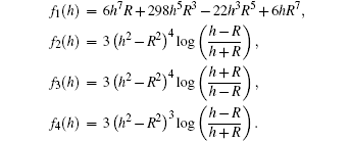† Corresponding author. E-mail:
The dipole–dipole interaction model is employed to investigate the angular dependence of the levitation and lateral forces acting on a small magnet in an anti-symmetric magnet/superconducting sphere system. Breaking the symmetry of the system enables us to study the lateral force which is important in the stability of the magnet above a superconducting sphere in the Meissner state. Under the assumption that the lateral displacement of the magnet is small compared to the physical dimensions of our proposed system, analytical expressions are obtained for the levitation and lateral forces as a function of the geometrical parameters of the superconductor as well as the height, the lateral displacement, and the orientation of the magnetic moment of the magnet. The dependence of the levitation force on the height of the levitating magnet is similar to that in the symmetric magnet/superconducting sphere system within the range of proposed lateral displacements. It is found that the levitation force is linearly dependent on the lateral displacement whereas the lateral force is independent of this displacement. A sinusoidal variation of both forces as a function of the polar and azimuthal angles specifying the orientation of the magnetic moment is observed. The relationship between the stability and the orientation of the magnetic moment is discussed for different orientations.
The phenomenon of a magnet floating above a superconductor has been studied for different geometrical shapes of the magnet as well as the superconducting sample. Different groups of researchers reported their experimental results of the magnetic levitation force,[1–7] while several theoretical models were adopted to explain and support the experimental works.[8–22] Coffey[10] and Yang[11] studied the case of a symmetric magnet/superconducting sphere system when the magnetic moment is oriented perpendicular to the surface of the sphere. Recently, based on the image method, the results of Coffey and Yang were reproduced as well as generalized for arbitrary orientations of the magnetic moment.[12] In this paper, we study the magnetic interaction between a point magnetic dipole of an arbitrary orientation levitated above a superconducting sphere in the Meissner state.
It is well known[10–12] that the force on a small magnet located exactly at the symmetry axis of a superconducting sphere has only one component in the vertical direction (it is called the levitation force). In order to have another component of the force (the lateral force, which is in the horizontal direction), we have to break the symmetry of the system by moving the small magnet laterally from the axis of symmetry (the vertical axis of the sphere as shown in Fig.
Using the dipole–dipole interaction model, we can derive analytical expressions for the levitation and lateral forces acting on the permanent small magnet above a superconducting sphere. Figure
The detailed description of this model has been given in the previous publications,[8,9] and in this section, we just give the final result. In the Meissner state, the magnetic induction



To simplify our calculations, a few assumptions are taken here. The superconductor is assumed to be in a perfect Meissner state in which the field is totally expelled by the superconductor, however in real superconductors, there is still a weak penetration of the magnetic field.[7] To avoid inconsistency, we work in the low field limit where the Meissner state is a good approximation that leads to accurate results regarding the interaction force.[24] This is made by assuming that the magnet is very small and, hence, the magnetic moment is very weak. Moreover, we ignore the demagnetization effect and focus on the qualitative behavior of the force in the system, because the analytical simulation of the demagnetization effect is complicated, and it will affect the magnitude of the force rather than its behavior.[24,25]
In this section, we calculate the integral in Eq. (

The superconductor/magnet system has anti-symmetry about the z axis. Therefore, the force on the magnet has two non-vanishing components: an upward force along the z axis, Fz (usually called the levitation force) and a second component in the plane perpendicular to the z axis, Fη (usually called the lateral force). Equations (



Figure
Figure
In Fig.
Figure
In Fig.
We calculated the levitation and the lateral forces between a small magnet and a superconducting sphere in the Meissner state using the dipole–dipole interaction model for the anti-symmetric superconductor/magnet system. We obtained analytical expressions for both forces as a function of the geometry of the magnet/superconductor system and the orientation of the magnetic moment of the magnet. The results showed that the levitation force does not depend on the lateral displacement when the magnetic moment has a polar angle of 0° or 90° and for any arbitrary azimuthal angle. The levitation force varies sinusoidally with the azimuthal angle and the magnet has a stable equilibrium at the azimuthal angle of 180° and an unstable equilibrium at the angle of 0° or 360°. The lateral force varies solenoidally with the azimuthal angle and the stability depends on the polar angle of the moment.
| 1 | |
| 2 | |
| 3 | |
| 4 | |
| 5 | |
| 6 | |
| 7 | |
| 8 | |
| 9 | |
| 10 | |
| 11 | |
| 12 | |
| 13 | |
| 14 | |
| 15 | |
| 16 | |
| 17 | |
| 18 | |
| 19 | |
| 20 | |
| 21 | |
| 22 | |
| 23 | |
| 24 | |
| 25 |








